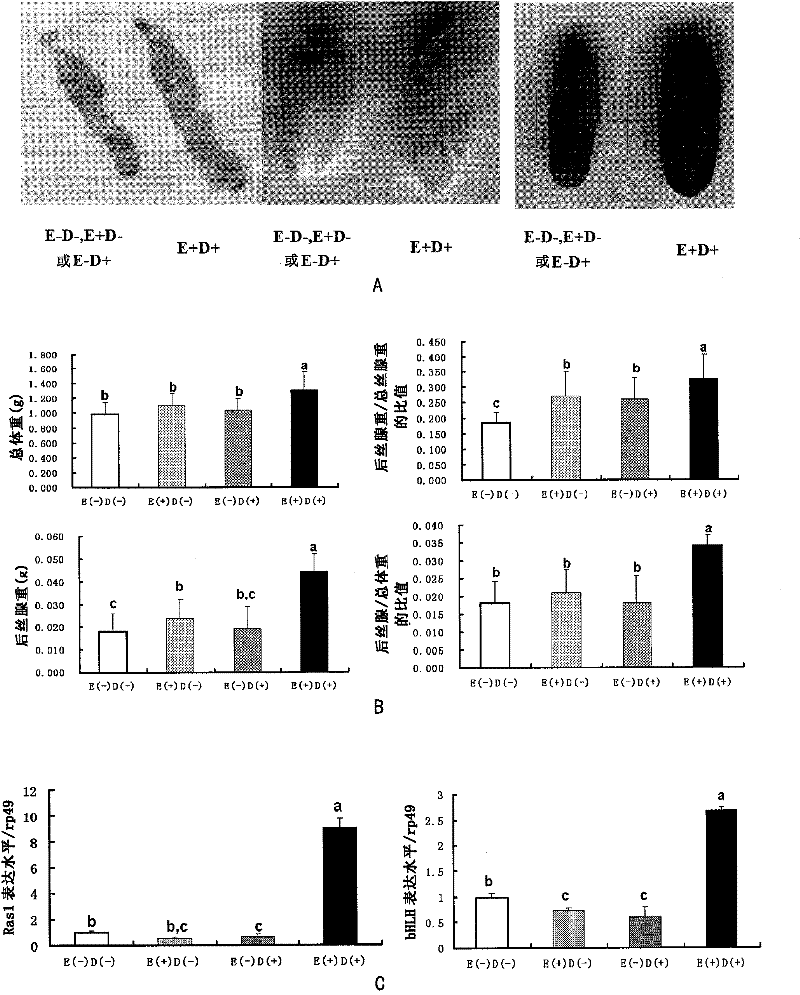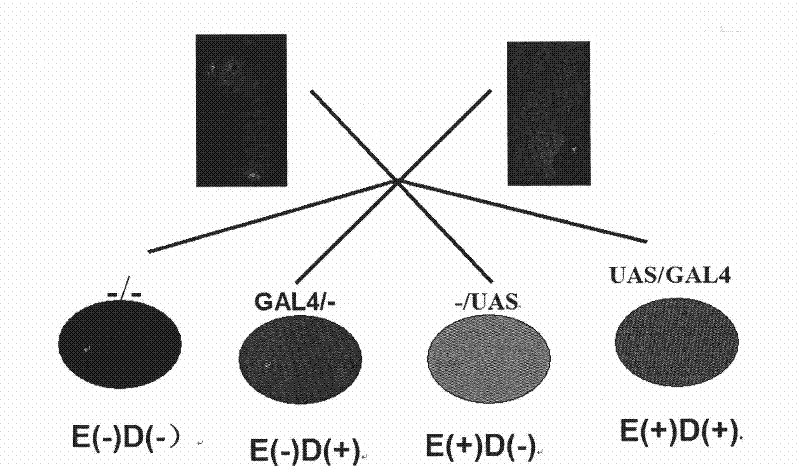Transgenic method for improving silk yield
A transgenic, silk technology, applied in genetic engineering, plant genetic improvement, botanical equipment and methods, etc., can solve problems such as lack
- Summary
- Abstract
- Description
- Claims
- Application Information
AI Technical Summary
Problems solved by technology
Method used
Image
Examples
Embodiment 1
[0113] Embodiment 1, construction transgenic vector
[0114] See Fil-GAL4 / 3XP3-DsRed figure 1 a. UAS-Ras1 V12 See / 3XP3-EGFP figure 1 b. Both of the above two vectors use the Piggybac transposon as the basic skeleton of the transgene, and the GAL4 line uses the fibroin light chain specifically expressed in the posterior silk gland as the promoter, and the artificial promoter specifically expressed in the eye and ganglion is selected as the screening marker. 3XP3-driven red fluorescent DsRed2. UAS lines carry a persistently active form of Ras1 v12 , the screening marker was changed to green fluorescent EGFP.
[0115] Fil-GAL4 / 3XP3-DsRed vector construction process, wherein the original vector is pBacA3-GAL4 / 3XP3-DsRed (obtained from the National Institute of Agricultural Sciences, Japan, reference AnjangTan, Hiromasa Tanaka, Toshiki Tamura, Takahiro Shiotsuki 2005.Precocious metamorphosis in transgenic silkworms overexpressing juvenile hormone esterase.Proc Natl Acad Sci...
Embodiment 2
[0117] Embodiment 2, the experimental analysis of transgenic silkworm acquisition and hybrid progeny
[0118] Transgenic silkworms of the above two plasmids were respectively obtained from a dimorphic variety Dazao (obtained from Southwest University) by microinjection. Specific method: After the silkworm chrysalis emerges, collect the male and female silkworm moths that have turned into moths at the same time, and disassemble them after mating under weak light at 25°C for 4 hours. Silkworm eggs were collected every hour, and the collected silkworm eggs were placed in an environment of 25°C for protection. And use the Eppendorf microinjector within 3 hours of spawning, inject 10-15nl of Fil-GAL4 / 3XP3-DsRed or UAS-Ras1 with a total concentration of 400ng / ul V12 / 3XP3-EGFP carrying an auxiliary carrier (pigA4, obtained from Southwest University), injected into silkworm eggs, sealed the injection port with non-toxic glue, sterilized with 35% formaldehyde steam for 5 minutes, and...
Embodiment 3
[0143] Embodiment 3, the expression level detection of Ras1-GTP
[0144] Ras1 activity detection kit (purchased from Millipore Company, catalog number 17-218) was used to detect the expression level of Ras in the transgenic silkworm hybrid progeny, that is, the expression level of Ras-GTP. Weighed 50 mg of the four genotype silk glands respectively , use the MLB lysate provided in the kit to centrifuge and absorb the supernatant, add 10ul of active form Ras1 binding substrate Raf-1 RBD agarose per 0.5ml cell extract. After incubating at 4°C for 45 minutes, centrifuge briefly, suck off the supernatant, wash three times with MLB washing solution, resuspend the agarose in 40ul 2×Laemmli reduced sample buffer, boil in water for 5 minutes, and centrifuge briefly to take 20ul of the supernatant was subjected to SDS protein electrophoresis, the protein was transferred to a nitrocellulose membrane, blocked with TBST containing 5% skimmed milk powder, and Ras1 primary antibody ratio 1:...
PUM
 Login to View More
Login to View More Abstract
Description
Claims
Application Information
 Login to View More
Login to View More - R&D
- Intellectual Property
- Life Sciences
- Materials
- Tech Scout
- Unparalleled Data Quality
- Higher Quality Content
- 60% Fewer Hallucinations
Browse by: Latest US Patents, China's latest patents, Technical Efficacy Thesaurus, Application Domain, Technology Topic, Popular Technical Reports.
© 2025 PatSnap. All rights reserved.Legal|Privacy policy|Modern Slavery Act Transparency Statement|Sitemap|About US| Contact US: help@patsnap.com



